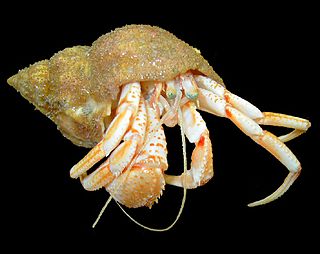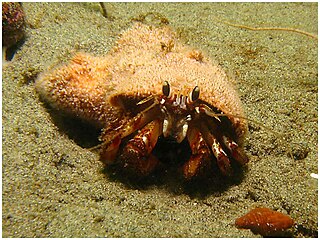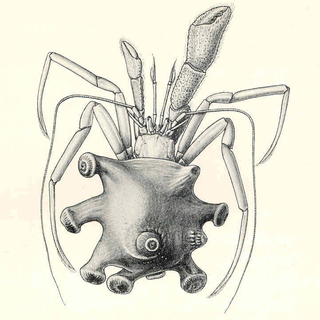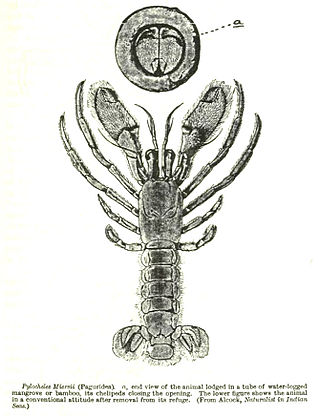
Hermit crabs are anomuran decapod crustaceans of the superfamily Paguroidea that have adapted to occupy empty scavenged mollusc shells to protect their fragile exoskeletons. There are over 800 species of hermit crab, most of which possess an asymmetric abdomen concealed by a snug-fitting shell. Hermit crabs' soft (non-calcified) abdominal exoskeleton means they must occupy shelter produced by other organisms or risk being defenseless.

King crabs are a taxon of decapod crustaceans that are chiefly found in cold seas. Because of their large size and the taste of their meat, many species are widely caught and sold as food with the most common being the red king crab.

Carcinisation is a form of convergent evolution in which non-crab crustaceans evolve a crab-like body plan. The term was introduced into evolutionary biology by L. A. Borradaile, who described it as "the many attempts of Nature to evolve a crab".

The genus Coenobita contains 17 species of terrestrial hermit crabs. Several species in this genus are kept as pets.

The halloween hermit crab, also known as the striped hermit crab or orange-legged hermit crab, is a brightly colored aquatic hermit crab of the family Diogenidae. Besides its ability to routinely clean algae in aquaria, the halloween hermit crab's festive striped coloration also appeals to enthusiasts; it is considered the most brightly colored hermit crab in normal aquarium use.

The Paguridae are a family of hermit crabs of the order Decapoda. The king crabs, Lithodoidea, are now widely understood to be derived from deep within the Paguridae, with some authors placing their ancestors within the genus Pagurus.

Pagurus is a genus of hermit crabs in the family Paguridae. Like other hermit crabs, their abdomen is not calcified and they use snail shells as protection. These marine decapod crustaceans are omnivorous, but mostly prey on small animals and scavenge carrion. Trigonocheirus and Pagurixus used to be considered subgenera of Pagurus, but the former is nowadays included in Orthopagurus, while the latter has been separated as a distinct genus.

The Parapaguridae are a family of marine hermit crabs from deep waters. Instead of carrying empty gastropod shells like other hermit crabs, they carry colonies of dozen or more sea anemones or zoanthids. Some genera, such as Bivalvopagurus and Tylaspis, do not inhabit shells. The following genera are included:

Paralomis is a genus of king crabs. It includes the following 69 species:

The Pylochelidae are a family of hermit crabs. Its members are commonly called the 'symmetrical hermit crabs'. They live in all the world's oceans, except the Arctic and the Antarctic, at depths of 2,000 m (6,600 ft). Due to their cryptic nature and relative scarcity, only around 60 specimens had been collected before 1987, when a monograph was published detailing a further 400.

Diogenes is a genus of hermit crabs.

Dardanus megistos, the white-spotted hermit crab or spotted hermit crab, is a species of hermit crab belonging to the family Diogenidae.

Clibanarius fonticola is a species of hermit crab from Vanuatu. It lives exclusively in fresh water, the only hermit crab in the world to do so. While a number of other hermit crabs are terrestrial or live in estuarine habitats, and certain brackish water species can tolerate low salinity levels for a time, no other hermit crab spends its entire life in fresh water; the only other fully freshwater anomurans are the South American aeglids.
Ciliopagurus substriatiformis was a species of hermit crab that existed during the Badenian stage.
The Pylojacquesidae are a small family of hermit crabs, comprising only two species in two genera. The family was erected in 2001, after two specimens at Museum für Naturkunde at the Humboldt-Universität zu Berlin were recognised as being quite distinct from other described hermit crabs. The family members differ from other hermit crabs in that their mandibles are chitinous and toothed.
Calcinus tubularis is a species of hermit crab. It is found in the Mediterranean Sea and around islands in the Atlantic Ocean, where it lives below the intertidal zone. Its carapace, eyestalks and claws are marked with numerous red spots. C. tubularis and its sister species, C. verrilli, are the only hermit crabs known to show sexual dimorphism in shell choice, with males using normal marine gastropod shells, while females use shells of gastropods in the family Vermetidae, which are attached to rocks or other hard substrates.
Porcellanopagurus edwardsi is a species of hermit crab that lives in the waters around New Zealand and its subantarctic islands.
Jacques Forest was a French carcinologist.
Calcinus verrillii, commonly known as Verrill's hermit crab, is a species of hermit crab in the genus Calcinus which is endemic to Bermuda. It was first described by the American zoologist Mary J. Rathbun and named in honour of the American zoologist Addison Emery Verrill, who spent much time with his students studying the geology and marine fauna of Bermuda.













